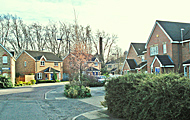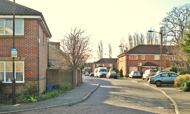St
Francis' Hospital
48 Constance Road, SE22 8DF
Medical
dates:
Medical
character:
General. Later, acute, geriatric, mental, younger disabled.
The Constance Road workhouse
of the Camberwell Union opened in 1895 with 898 inmates. It was
located on the opposite side of the railway line to St Saviour's Union Infirmary.
In the centre of the site was an administrative building accessed from an open courtyard through a large red brick central arch, which was dressed with stone and topped with a Dutch gable. The 2-storey wings of the administrative block had bay windows and shaped gables. At the rear was a small chapel.
The dormitory pavilions flanked the administration block. Four storeys high and built of stock brick with red brick dressings, they were connected by covered walkways. Iron lattice 'escape bridges' connected the upper floors of the dormitories.
In 1914 it became the Constance Road Institution, caring for unmarried mothers, the handicapped, the elderly and the mentally ill.
In 1930, with abolition of the Guardians and the transfer of the Poor Law hospitals to local county councils, the LCC took over the administration
of the Institution. In 1937 it was renamed St Francis' Hospital. In 1938 a nurses' hostel was built.
During WW2, on the evening of 12th July 1944 a V1 flying bomb impacted on the west side of the Hospital. The boiler house was demolished and several Hospital buildings were damaged.
In 1948 the Hospital was incorporated into the NHS under the control of the Camberwell Hospitals Management Committee, part of the South East Metropolitan Regional Hospital Board. It had 545 beds for the chronic sick and for mental observation.
In 1966 the Hospital joined the King's College (Teaching) Hospital Group. It had 512 beds for long stay patients.
In 1974, following a major reorganisation of the NHS, the Hospital came under the control of the Kings (Teaching) District Health Authority, part of the Lambeth, Southwark and Lewisham (Teaching) Area Health Authority. It had 414 beds for long stay patients.
After another major reorganisation of the NHS in 1982, the Hospital came under the control of the Camberwell District Health Authority, part of the South East Thames Regional Health Authority.
In 1984 it became the north wing of the Dulwich Hospital. A tunnel under the railway line connected both sites. The wheeled stretchers had pneumatic tyres to cushion the ride on the uneven surface.
The Hospital closed in 1991 and services moved to Dulwich Hospital or King's College Hospital.
In the centre of the site was an administrative building accessed from an open courtyard through a large red brick central arch, which was dressed with stone and topped with a Dutch gable. The 2-storey wings of the administrative block had bay windows and shaped gables. At the rear was a small chapel.
The dormitory pavilions flanked the administration block. Four storeys high and built of stock brick with red brick dressings, they were connected by covered walkways. Iron lattice 'escape bridges' connected the upper floors of the dormitories.
In 1914 it became the Constance Road Institution, caring for unmarried mothers, the handicapped, the elderly and the mentally ill.
In 1930, with abolition of the Guardians and the transfer of the Poor Law hospitals to local county councils, the LCC took over the administration
of the Institution. In 1937 it was renamed St Francis' Hospital. In 1938 a nurses' hostel was built.
During WW2, on the evening of 12th July 1944 a V1 flying bomb impacted on the west side of the Hospital. The boiler house was demolished and several Hospital buildings were damaged.
In 1948 the Hospital was incorporated into the NHS under the control of the Camberwell Hospitals Management Committee, part of the South East Metropolitan Regional Hospital Board. It had 545 beds for the chronic sick and for mental observation.
In 1966 the Hospital joined the King's College (Teaching) Hospital Group. It had 512 beds for long stay patients.
In 1974, following a major reorganisation of the NHS, the Hospital came under the control of the Kings (Teaching) District Health Authority, part of the Lambeth, Southwark and Lewisham (Teaching) Area Health Authority. It had 414 beds for long stay patients.
After another major reorganisation of the NHS in 1982, the Hospital came under the control of the Camberwell District Health Authority, part of the South East Thames Regional Health Authority.
In 1984 it became the north wing of the Dulwich Hospital. A tunnel under the railway line connected both sites. The wheeled stretchers had pneumatic tyres to cushion the ride on the uneven surface.
The Hospital closed in 1991 and services moved to Dulwich Hospital or King's College Hospital.
Present status (January
2008)
The site was sold for redevelopment and the Hospital buildings were demolished in 1993. A housing estate now occupies the site.
The site was sold for redevelopment and the Hospital buildings were demolished in 1993. A housing estate now occupies the site.


Completed in 1998, the housing complex mainly consists of 2-storey houses with gardens
Beasley J 2009 East Dulwich Through Time. Stroud, Amberley.
www.aim25.ac.uk
www.camberwellboroughcouncil.co.uk
www.kch.nhs.uk
www.kcl.ac.uk
www.kingscollections.org
www.pastscape.org.uk
www.workhouses.org.uk
Return to home page